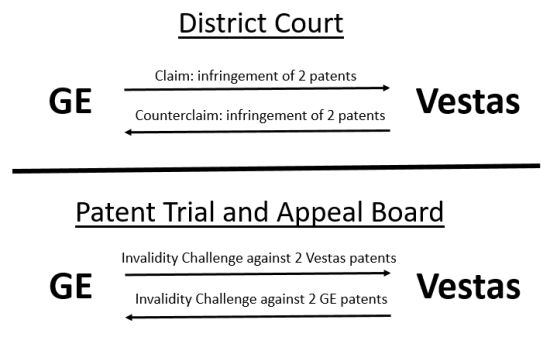- GE asked a federal court to split its patent litigation with Vestas into two parts, which would allow the litigation to proceed with respect to GE's claims against Vestas while delaying a trial on Vestas' counterclaims against GE.
- Vestas filed invalidity challenges at the Patent Trial and Appeal Board against the two GE patents asserted in the litigation.
The patent litigation between two titans of the wind turbine industry continues to heat up as the parties fight over the validity of each other's patents and the scope of the dispute itself. GE and Vestas, reported to control more than 80% of the US wind turbine market, have been engaged in patent litigation since last summer. Recent developments in the case have the potential to greatly impact the number of claims heard at trial and the relative bargaining power between the parties.
The parties have been litigating the case in two forums: a US federal court in California and the Patent Trial and Appeal Board (PTAB), an adjudicatory unit of the U.S. Patent and Trademark Office. Last summer, GE brought claims asserting two patents in federal court relating to so-called Zero Voltage Ride Through (ZVRT) technology against Vestas. Vestas responded in federal court with counterclaims of infringement against GE that asserted two patents. GE then moved part of the case to the PTAB, where it filed challenges to the validity of Vestas' patents.
Since its creation in 2012, the PTAB has been widely seen as the preferred forum for bringing invalidity challenges against patents. These challenges may also be brought in federal court during an infringement trial, but the particular rules and technical expertise of the PTAB have generally made it preferable to litigate patent validity there. This preference among litigants has made two-forum litigation (such as the GE and Vestas dispute) common for patent litigation. Infringement claims and damages are typically heard by a federal jury, while the issue of validity is heard by a panel of PTAB judges.
In federal court last month, GE filed a motion to sever and stay the Vestas counterclaims. In the motion, GE asked the court to split the case into two parts. Per GE's request, a first part of the case containing GE's infringement claims against Vestas would continue on the current case schedule. A second part of the case, containing Vestas' infringement counterclaims against GE, would not proceed until the PTAB has concluded its review of the Vestas patents. GE argued that this two-part schedule would be a more efficient use of judicial resources than continuing through the case with both claims and counterclaims. In the event the PTAB finds the Vestas patents invalid, Vestas would be left without counterclaims against GE and the entire second part of the case would not be necessary at all.
Motions to sever appear to be infrequently granted. However, GE may have gotten the reaction it was looking for because Vestas quickly responded to GE's motion by filing invalidity challenges against the GE patents at the PTAB. A summary of each parties' claims and invalidity challenges is presented below:

By exposing Vestas to the risk that the counterclaims would be left behind (thus resulting in a potential trial in which Vestas faced liability for patent infringement while GE faced little to no liability), GE may have prompted Vestas to quickly file challenges at the PTAB against GE's asserted patents. This move restores a rough balance of risk to the case: both GE and Vestas now face the risk of being found liable for patent infringement in the District Court and the risk of losing their valuable patents to invalidity challenges at the PTAB.
This blog will continue to monitor and report on what is shaping up to be a fascinating chess match between two of the largest competitors in the US wind turbine market.
Disclaimer: This Alert has been prepared and published for informational purposes only and is not offered, nor should be construed, as legal advice. For more information, please see the firm's full disclaimer.
